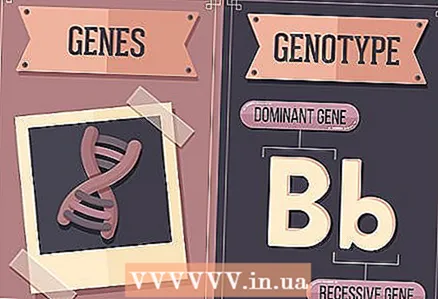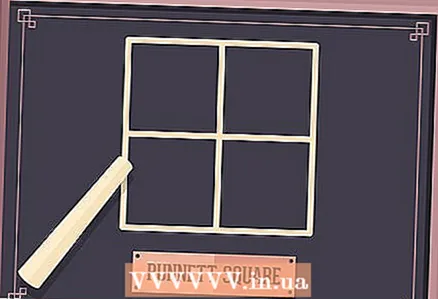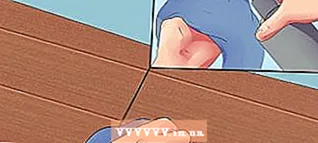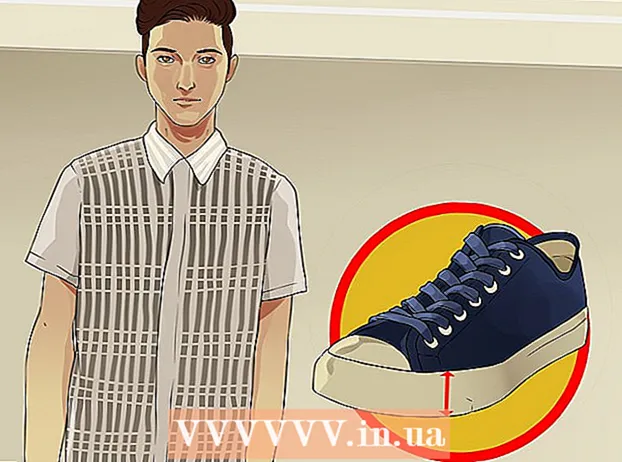Author:
Ellen Moore
Date Of Creation:
17 January 2021
Update Date:
1 July 2024

Content
- Steps
- Part 1 of 2: Building a Pennett Lattice
- Part 2 of 2: Filling the Pennett Grid
- Tips
- Additional articles
The Pennett grating was invented by the English geneticist Reginald Pennett in the early 20th century.It makes it quite easy to determine the combination of genes that can be obtained in offspring as a result of crossing two parental individuals. In monohybrid crosses, both parents have the same gene.
Steps
Part 1 of 2: Building a Pennett Lattice
 1 Become familiar with the concepts of gene and genotype. A genotype is the inherited genetic code of an individual. The genotype is determined by the alleles of the two chromosomes that are inherited from the parent. An allele is a special kind of gene. For example, there is a genetic code for hair color, with one allele for blond and the other for brown hair.
1 Become familiar with the concepts of gene and genotype. A genotype is the inherited genetic code of an individual. The genotype is determined by the alleles of the two chromosomes that are inherited from the parent. An allele is a special kind of gene. For example, there is a genetic code for hair color, with one allele for blond and the other for brown hair. - Each individual has two chromosomes with two alleles that form its genotype, and these alleles are designated by letters.
- Capital letters correspond to dominant alleles, and lowercase letters are used to denote recessive alleles.
- To designate alleles, you can use any letters that are convenient for you. Usually the letter of the dominant allele comes first.
- For example, let us denote by the Latin letter B the dominant gene for brown hair, and the letter b is a recessive gene for blond hair.
 2 Draw a 2 x 2 table. As the name implies, the Punnett lattice is a square divided into equal cells. Draw a square and draw two straight lines (one horizontal and one vertical) through its center.
2 Draw a 2 x 2 table. As the name implies, the Punnett lattice is a square divided into equal cells. Draw a square and draw two straight lines (one horizontal and one vertical) through its center. - Make the cells large enough to fit two letters in each.
- Also, leave enough space at the top and left of the square.
 3 Write down the genotype of one of the parents above the grid. Suppose the mother has brown hair and the genotype Bb - in this case, write down the letter B above the top left cell and b above the top right cell.
3 Write down the genotype of one of the parents above the grid. Suppose the mother has brown hair and the genotype Bb - in this case, write down the letter B above the top left cell and b above the top right cell. - Above the grid, you can write the genotype of either of the two parents.
- Write one letter above each cell.
 4 Write down the genotype of the second parent to the left of the grid. For example, if the father has brown hair, and at the same time he has the genotype BB, write down the letter B to the left of the top left cell and another letter B to the left of the bottom left cell.
4 Write down the genotype of the second parent to the left of the grid. For example, if the father has brown hair, and at the same time he has the genotype BB, write down the letter B to the left of the top left cell and another letter B to the left of the bottom left cell.
Part 2 of 2: Filling the Pennett Grid
 1 Write the corresponding alleles in the boxes. Each allele will go into two cells below it or to the right of it, depending on where it is located. For example, if the allele B stands over the top left corner of the lattice, write down the letter B into two cells that are located below it. If the allele B stands to the left of the top row of the table, you should write B in two cells to the right of it. Fill in all the cells of the grid so that each contains two alleles, one from each parent.
1 Write the corresponding alleles in the boxes. Each allele will go into two cells below it or to the right of it, depending on where it is located. For example, if the allele B stands over the top left corner of the lattice, write down the letter B into two cells that are located below it. If the allele B stands to the left of the top row of the table, you should write B in two cells to the right of it. Fill in all the cells of the grid so that each contains two alleles, one from each parent. - It is customary to write down the dominant (capital letter) allele first, and then the recessive (lowercase letter) allele.
- For our example with two parents with brown hair in the cells, we get combinations BB or Bb... Thus, you will find out the possible genotypes of the offspring. However, if one of the parents had blond hair, the genotype could be recessive. bb.
 2 Count the number of cells for each genotype. With monohybrid crossing, there are only three possible genotypes: BB, Bb and bb. BB (brown hair) and bb (blond hair) are homozygous combinations, that is, in them the gene consists of two identical alleles. Bb (brown hair) is a heterozygous combination - in this case, the gene consists of two different alleles. With some variants of crossing, only one or two genotypes may appear.
2 Count the number of cells for each genotype. With monohybrid crossing, there are only three possible genotypes: BB, Bb and bb. BB (brown hair) and bb (blond hair) are homozygous combinations, that is, in them the gene consists of two identical alleles. Bb (brown hair) is a heterozygous combination - in this case, the gene consists of two different alleles. With some variants of crossing, only one or two genotypes may appear. - In our example, when crossing BB x Bb two options will appear in the Pennett lattice BB and two Bb.
- When crossing two homozygous parents with the same genotypes (BB x BB or bb x bb) all possible genotypes of offspring will also be homozygous (BB or bb).
- When crossing two homozygous parents with different genotypes (BB x bb) you get four combinations Bb.
- When crossing a heterozygous parent with a homozygous (BB x Bb or bb x Bb), you get two homozygous (BB or bb) and two heterozygous (Bb) combinations.
- When crossing two heterozygous parents (Bb x Bb), we get two homozygous (1 BB and 1 bb) and two heterozygous (Bb) combinations.
 3 Calculate the ratio of phenotypes. Using the results obtained above, it is possible to determine the ratio of phenotypes. A phenotype is a physical characteristic of a gene, such as hair or eye color. In the presence of completely dominant traits in a heterozygous genotype (a combination of different alleles), a dominant phenotype will appear.
3 Calculate the ratio of phenotypes. Using the results obtained above, it is possible to determine the ratio of phenotypes. A phenotype is a physical characteristic of a gene, such as hair or eye color. In the presence of completely dominant traits in a heterozygous genotype (a combination of different alleles), a dominant phenotype will appear. - When crossing BB x Bb four phenotypes with a dominant brown hair color are possible (2 BB and 2 Bb), and the recessive variant with blond hair (bb) is absent, so the ratio will be 4: 0. Thus, 100% of the offspring in the first generation will have brown hair, with 50% being homozygous and 50% heterozygous.
Tips
- Check how the symptom in question manifests itself. For example, if you are asked to find the ratio of phenotypes using the Punnett lattice, it will depend on the type of this trait: it may not be completely dominant, codominant, or completely dominant.
Additional articles
 How to build a Punnett lattice
How to build a Punnett lattice  How to work with a Pennett lattice
How to work with a Pennett lattice  How to make a 3D model of an animal or plant cell
How to make a 3D model of an animal or plant cell  How to make a model of a cell
How to make a model of a cell  How to study biology
How to study biology  How to prepare a frog
How to prepare a frog  How to learn anatomy
How to learn anatomy  How to draw a square
How to draw a square  How to grow mold
How to grow mold  How to find a four leaf clover
How to find a four leaf clover  How to activate yeast
How to activate yeast  How to determine the age of a tree
How to determine the age of a tree  How to identify a cherry tree
How to identify a cherry tree  How to identify trees
How to identify trees



